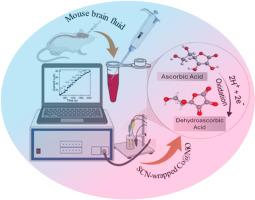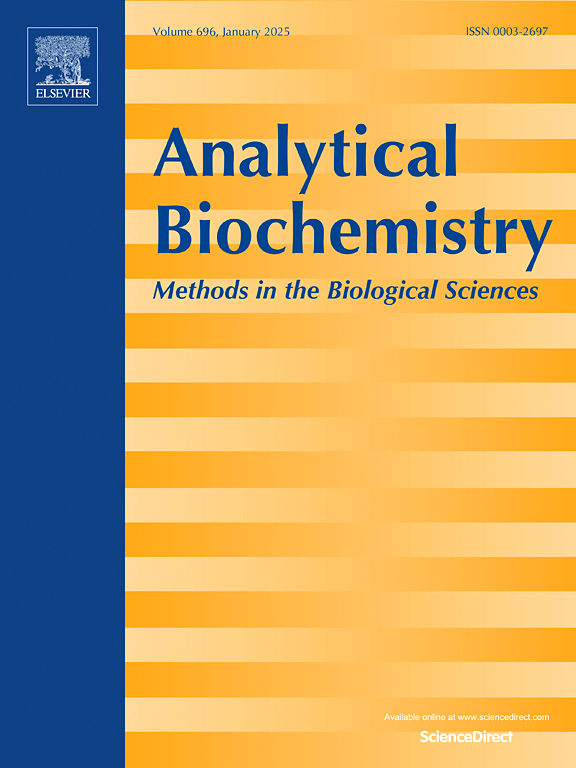scn包覆Co@NiO纳米传感器实时电化学检测小鼠脑匀浆中抗坏血酸。
IF 2.5
4区 生物学
Q2 BIOCHEMICAL RESEARCH METHODS
引用次数: 0
摘要
氧化应激是帕金森氏症、阿尔茨海默氏症和亨廷顿氏症等神经系统疾病的主要关键因素。抗坏血酸(AA)是一种重要的大脑抗氧化剂,通过清除活性氧来保护神经元,其波动会损害神经元功能。因此,精确监测人类AA对早期诊断和疾病管理至关重要。然而,尽管基于无贵金属纳米复合材料的电化学传感器取得了重大进展,但由于低生理浓度和共存生物分子的干扰,精确检测仍然具有挑战性,这限制了传感器的灵敏度、选择性和实时适用性。为了解决这些限制,我们合成了用硫脲包裹的钴掺杂氧化镍(Co@NiO)和多巴胺(SCN包裹Co@NiO),用于选择性和敏感地检测AA。SCN基团通过与AA的氢键相互作用提供了丰富的结合位点,从而提高了选择性,而Co@NiO纳米结构催化促进AA氧化,显著提高了灵敏度,实现了对干扰物种的高效传感效果。结果表明,该材料具有良好的灵敏度(0.1837 μA/nM/cm2)、较宽的线性范围(5nM-20μM)和较低的检出限(12.72 nM)。此外,所设计的电极即使在各种干扰物质存在的情况下也对AA表现出良好的选择性,突出了其在实际应用中的实时分析潜力。本文章由计算机程序翻译,如有差异,请以英文原文为准。

Real-time electrochemical detection of Ascorbic acid in mouse brain homogenate using SCN-wrapped Co@NiO Nanosensor
Oxidative stress, a major key factor to neurological disorders such as Parkinson's, Alzheimer's, and Huntington's disease. Ascorbic acid (AA), a vital brain antioxidant, protects neurons by scavenging reactive oxygen species, and its fluctuations can damage neuronal function. Therefore, precise monitoring of AA in humans is critical for early diagnosis and disease management. However, despite significant advancements in noble metal-free nanocomposite based electrochemical sensors, precise detection remains challenging due to low physiological concentrations and interference from coexisting biomolecules, which limit sensor sensitivity, selectivity, and real-time applicability. To address these limitations herein, we synthesized cobalt-doped nickel oxide (Co@NiO), wrapped with thiourea, and dopamine (SCN- wrapped Co@NiO) for selective and sensitive detection of AA. The SCN groups provide abundant binding sites through hydrogen-bonding interactions with AA, thereby enhancing selectivity, while the Co@NiO nanostructure catalytically facilitates AA oxidation, significantly improving sensitivity and enabling efficient sensing efficacy against interfering species. The findings demonstrated that the fabricated material exhibits excellent sensitivity (0.1837 μA/nM/cm2), a wide linear range (5nM–20μM), and low detection limit (12.72 nM). Furthermore, the designed electrode has shown excellent selectivity towards AA even in presence of various interfering species, highlighting its potential in real-time analysis for practical applications.
求助全文
通过发布文献求助,成功后即可免费获取论文全文。
去求助
来源期刊

Analytical biochemistry
生物-分析化学
CiteScore
5.70
自引率
0.00%
发文量
283
审稿时长
44 days
期刊介绍:
The journal''s title Analytical Biochemistry: Methods in the Biological Sciences declares its broad scope: methods for the basic biological sciences that include biochemistry, molecular genetics, cell biology, proteomics, immunology, bioinformatics and wherever the frontiers of research take the field.
The emphasis is on methods from the strictly analytical to the more preparative that would include novel approaches to protein purification as well as improvements in cell and organ culture. The actual techniques are equally inclusive ranging from aptamers to zymology.
The journal has been particularly active in:
-Analytical techniques for biological molecules-
Aptamer selection and utilization-
Biosensors-
Chromatography-
Cloning, sequencing and mutagenesis-
Electrochemical methods-
Electrophoresis-
Enzyme characterization methods-
Immunological approaches-
Mass spectrometry of proteins and nucleic acids-
Metabolomics-
Nano level techniques-
Optical spectroscopy in all its forms.
The journal is reluctant to include most drug and strictly clinical studies as there are more suitable publication platforms for these types of papers.
 求助内容:
求助内容: 应助结果提醒方式:
应助结果提醒方式:


